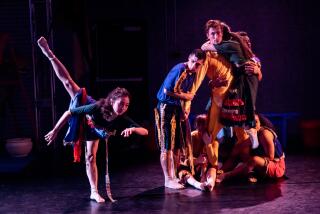Guided Imagery in Tai Chi ‘Dance’ Enlisted to Fight Crippling Arthritis : Fitness: A blend of the ancient Chinese exercise, poetry and mental imagery can help sufferers retain and expand their range of motion, proponents say.
- Share via
WASHINGTON — A version of a Chinese exercise is now a weapon against arthritis.
Tai chi’s slow, gentle movements help arthritis victims get the widest motion from their joints, say proponents of the ROM Dance, which combines elements of tai chi with guided imagery.
The routine, which takes less than nine minutes, is being promoted by the Arthritis Foundation and the ROM Dance Institute, a nonprofit group that handles the program’s development and dissemination.
The Institute in Madison, Wis., coordinates classes and distributes videotapes for professional or home use.
ROM stands for range of motion--how far a joint will let a limb bend. Getting the most from their joints is especially important for people with joint diseases, because range of motion can shrink with disuse.
The ROM Dance can be used separately or incorporated into the foundation’s PACE (People with Arthritis Can Exercise) classes, which include fitness and strength, said Michele L. Boutaugh, the Atlanta-based foundation’s vice president for patient and community services.
However, the institute says arthritis victims should not start an exercise program without a professional’s advice.
Some exercisers use the ROM Dance as a warm-up, Boutaugh said. The movements include slow reaches, sometimes from a sitting position, and gentle swings of the legs.
“This incorporates the most elementary, basic principles of tai chi,” said ROM Dance co-creator Patricia Yu, a tai chi instructor in Madison. Tai chi itself is far more complicated and requires far more coordination than the variation developed for range of motion rehabilitation, she said.
The program has been used with rheumatoid arthritis, an autoimmune disorder that can make movement painful and the disease’s sufferers stiff and deformed. It’s also part of the foundation’s Lupus Self-Help Program aimed at victims of the autoimmune disease of connective tissue.
The ROM Dance’s benefits are equivalent to those of other programs, but its focus on range of motion and body awareness make it especially valuable, Boutaugh said.
The movements are coupled with poetry aimed at getting people to put the stress of their lives aside and relax. Stress can increase the perception of pain, said Teresa J. Brady, a medical adviser to the foundation.
“I like it because of the combination of range of motion and relaxation,” said Brady, executive director of the Minnesota Arthritis Institute in Minneapolis. “That’s something we don’t have integrated into a lot of exercise routines.”
The program helps to fight the depression and fatigue that can accompany a chronic, debilitating illness, said Lilly Depka of Tucson, Ariz., a lupus sufferer and ROM Dance instructor.
“The story line has a lot of imagery built in--a very strong relaxation-meditation part,” Depka said. “That increases the enjoyment of movement.”
One story line has the participant visualize being at a beach, splashing in the water and feeling the sunlight, meeting a friend, sharing thoughts and finally parting.
The free-form verse is synchronized to the movement. As the poetry speaks of scooping warm water overhead, “covering me with a warm waterfall,” the exerciser’s arms move gracefully overhead.
People who like imagery and ritual will like the ROM Dance, said Diane Harlowe, a co-creator of the program with Yu and director of Occupational Therapy at St. Mary’s Hospital Medical Center in Madison.
“We actually wind up playing with sunbeams,” Harlowe said. “The verse brings your consciousness to a sense of your relationship with nature, others and the universe,”
The ROM Dance also draws a spiritual aspect from the tai chi concept that an energy which fills creation can be tapped and directed, she said.
For instance, tai chi works as a meditation, requiring people to pay attention solely to the present, and let distracting thoughts float away, she said. But it can be done solely as an exercise.
“The use of that slow movement not only assists in maintaining consciousness in the present but is also excellent as an exercise,” Harlowe said. “The ROM Dance ends with bringing the hands together in the prayer position--which is very good for wrist extension.”
EDITOR’S NOTE: Those who wish more information on the ROM Dance may call the ROM Institute at (800) 765-3433.
More to Read
Sign up for Essential California
The most important California stories and recommendations in your inbox every morning.
You may occasionally receive promotional content from the Los Angeles Times.













